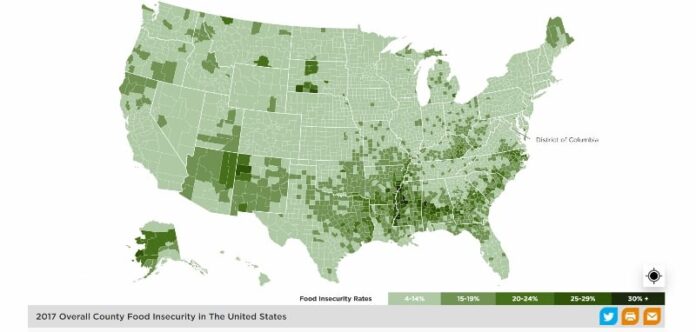 Feeding America Southwest Virginia announced the release of Map the Meal Gap 2019, the latest report by Feeding America® on food insecurity and the cost of food at both the county and congressional district level. It is the only study that provides food insecurity data at the local level.
Feeding America Southwest Virginia announced the release of Map the Meal Gap 2019, the latest report by Feeding America® on food insecurity and the cost of food at both the county and congressional district level. It is the only study that provides food insecurity data at the local level.
Map the Meal Gap 2019 reveals that food insecurity exists in every county in Feeding America Southwest Virginia’s service area. It also shows that children are more likely to be food insecure, with the child food insecurity rate at 16.9% compared to 12.1%% for the overall population for Southwest Virginia.
“There isn’t a single state or county in America free from child hunger, and it is within our collective power to change that and ensure that today’s children are tomorrow’s leaders,” said Claire Babineaux-Fontenot, chief executive officer of Feeding America. “The Feeding America nationwide network of food banks is investing in our nation’s future by helping to provide over 146 million meals to children every year. Still, Map the Meal Gap highlights that more must be done. Together food banks, corporations, policymakers, donors, volunteers and advocates can solve hunger.”
“I encourage everyone to visit the website, map.feedingamerica.org to find out what hunger looks like in their community and get involved to be part of the solution,” Babineaux-Fontenot continued. “One way is to tell Congress to invest in kids during Child Nutrition Reauthorization legislation and increase access to food for kids during the summer. Your voice matters and we can make a difference.”
Overall food insecurity in Southwest Virginia ranges from a low of 6.9% of the population in Botetourt County up to 20.3% in city of Martinsville.
The analysis also finds that 25.3% of residents of Southwest Virginia who are food insecure are likely ineligible for federal nutrition assistance under current program requirements. This means that many households must rely even more on charitable food assistance such as Feeding America Southwest Virginia.
“Food insecurity remains a critical issue in Southwest Virginia, even as the country has seen positive movement in economic and other factors,” said Pamela Irvine, chief executive officer of Feeding America Southwest Virginia. “It is especially serious when we consider the effects of food insecurity on our children. Without proper nutrition, we know that children’s physical, mental and emotional health suffer, and they cannot reach their potential,” she continued. “Feeding America Southwest Virginia is dedicated to supporting the health of children and families through a variety of programs and services provided by our dedicated supporters.”
Feeding America Southwest Virginia is a member of Feeding America’s hunger-relief network comprised of 200 food banks and 60,000 food pantries and meal programs that together provides food assistance to more than 40 million people in the U.S. struggling with hunger. Last year, Feeding America Southwest Virginia provided 118,107 individuals per month with meals and/or groceries through direct distributions and its 354-strong network of partner feeding programs.
Map the Meal Gap 2019 uses data from the U.S. Department of Agriculture, U.S. Census Bureau, U.S. Bureau of Labor Statistics and food price data and analysis provided by Nielsen, a global provider of information and insights. The study is supported by The Howard G. Buffett Foundation, Conagra Brands Foundation and Nielsen.
Key local findings:
- 10 localities in Southwest Virginia saw overall increases in their food insecurity rate: Alleghany County, Bedford County, Botetourt County, Franklin County, Grayson County, Pulaski County, Roanoke County, Smyth County, Washington County and Bristol City.
- The food insecurity rate among children is higher in 34 of the 35 localities FASWVA serves than the overall rate, reflecting a national trend.
- Martinsville City (20.3%), Danville City (19.9%), and Radford City (19.6%), remain the top three localities in Southwest Virginia with highest overall food insecurity rates.
The study’s findings underscore the extent of need that remains in communities in Southwest Virginia and across the U.S., despite national measures from the USDA that indicate overall improvement.
Dr. Craig Gundersen, Professor of Agricultural and Consumer Economics at the University of Illinois, Executive Director of the National Soybean Research Laboratory and a member of Feeding America’s Technical Advisory Group is the lead researcher of Map the Meal Gap 2019.
This is the ninth consecutive year that Feeding America has conducted the Map the Meal Gap study.
The Map the Meal Gap 2019 interactive map allows policymakers, state agencies, corporate partners, food banks and advocates to develop integrated strategies to fight hunger on a community level.
A summary of the findings, an interactive map of the United States, and the full report are available at map.feedingamerica.org.
Join the conversation about Map the Meal Gap 2019 on Twitter using #MealGap

